How Photoelectric Sensors Enhance Automation Efficiency
Core Mechanisms of Photoelectric Sensing
Photoelectric sensors are essential tools in automation that operate by using light to identify the presence or absence of an object. The fundamental principle behind photoelectric sensing lies in emitting a beam of light and detecting its reflection or interruption. When an object passes through this beam, the sensor detects changes in light, thereby identifying the object's location. Light modulation plays a crucial role, ensuring that sensors can discern objects accurately in diverse environments. Sensors use different wavelengths, ranging from infrared to visible light, to accommodate various detection ranges and applications. This versatility allows them to function effectively, whether in dimly lit areas or under direct sunlight.
Studies have demonstrated that incorporating photoelectric sensors significantly enhances operational efficiency. For instance, their application in automated production lines can reduce error rates, ensuring smoother operations. By minimizing manual intervention, these sensors also contribute to reducing workload and increasing precision. This increase in efficiency not only improves productivity but also supports industries in meeting growing demands for automation. As such, photoelectric sensors are paramount in modern automated systems for optimizing performance and reliability.
Through-Beam, Retroreflective, and Diffuse Sensor Types
There are three main types of photoelectric sensors: through-beam, retroreflective, and diffuse, each offering distinct benefits for automation efficiency. Through-beam sensors consist of an emitter and receiver placed opposite each other, detecting objects when the light beam is interrupted. These sensors are known for their accuracy and long-range capabilities, making them ideal for applications where precise detection over large distances is required. Retroreflective sensors integrate both the emitter and receiver in a single unit, with light reflecting off a target back to the sensor. This setup simplifies installation and maintenance while providing reliable medium-range detection.
Diffuse sensors work by reflecting emitted light off objects directly back to the receiver, ensuring effective short-range detection. These sensors are perfect for environments where objects vary in color or surface reflectivity. Their sensitivity to different material characteristics enhances the flexibility and adaptability of automated systems. According to industry reports, companies utilizing these sensor types notice improved detection reliability. A survey highlighted that manufacturers using retroreflective and diffuse sensors experience a noticeable reduction in processing errors, pointing to the sensors' role in boosting efficiency.
In conclusion, the diverse applications of these sensor types cater to various industry needs, ensuring efficient automation tailored to specific operational demands.## Critical Applications in Modern Industrial Systems
Object Detection in Conveyor and Packaging Lines
In modern industrial systems, photoelectric sensors play a crucial role in object detection on conveyor and packaging lines. By leveraging these sensors, industries achieve optimal flow of products, ensuring continuous and seamless production processes. Notably, photoelectric sensors enhance the capabilities of conveyor systems by precisely detecting the arrival and presence of objects, thereby reducing the chance of errors and bottlenecks. This efficiency is reflected in industry reports that highlight significant reductions in downtime and notable improvements in throughput achieved through automation. As companies strive to meet increasing production demands, integrating photoelectric sensors proves essential in boosting operational efficiency while maintaining high packaging standards in industrial settings.
Precision Positioning in Robotic Assembly
Photoelectric sensors are integral to achieving high precision in robotic assembly tasks. Through accurate detection and alignment capabilities, these sensors ensure that robotic systems perform assembly operations with minimal errors. For example, deploying photoelectric sensors in assembly lines allows for the precise positioning of parts, which is essential for maintaining consistent product quality. Experts in the field consistently acknowledge that the incorporation of these sensors directly translates to increased assembly accuracy, reducing material waste and optimizing resource utilization in manufacturing environments. Consequently, industries benefit through not only cost savings but also by meeting stringent quality requirements expected in today's market demands.
Safety Interlocks and Machine Guarding
Incorporating photoelectric sensors in safety interlocks and machine guarding systems is paramount to ensuring workplace safety. These sensors provide a reliable means of detecting potential hazards and triggering safety protocols to protect both personnel and machinery. Safety organizations underscore the importance of utilizing photoelectric sensors to comply with established safety guidelines and prevent workplace accidents. For instance, sensors quickly detect interruptions in light beams that indicate an unauthorized entry into hazardous areas, prompting immediate machine shutdown to avert injuries. By implementing these safety mechanisms, industries enhance their protective measures, thereby safeguarding employees and equipment while simultaneously adhering to regulatory compliance.## Technical Advantages Driving Industry Adoption
Non-Contact Operation and Reduced Maintenance
Photoelectric sensors offer a distinct advantage in industrial applications through their non-contact operation, which leads to reduced maintenance needs. By using optical properties to sense objects, these sensors avoid physical wear and tear that typically plague contact-based systems. This design drastically minimizes maintenance intervals, reducing associated costs. According to industry studies, non-contact sensors can cut down maintenance expenses by up to 30%. This not only contributes to cost-effectiveness but also ensures a more uninterrupted workflow, as machinery uptime is significantly improved.
High-Speed Performance in Dynamic Environments
Another compelling feature of photoelectric sensors is their high-speed performance suitable for dynamic and variable environments. These sensors are designed to quickly detect and react to changes, making them ideal for high-speed production scenarios. They boast impressive performance metrics, such as response times as short as 30 microseconds, allowing them to operate effectively even in rapidly changing conditions. This ensures robust functionality in environments where precision and speed are crucial, such as in automated sorting facilities or high-speed conveyance systems.## Overcoming Challenges in Sensor Implementation
Environmental Interference Solutions
One of the primary challenges when implementing photoelectric sensors is dealing with environmental interference. Factors like dust, fog, and reflective surfaces can disrupt sensor accuracy. For instance, dust accumulation on sensor lenses can obscure light paths, while fog can scatter the emitted beams, leading to erroneous readings. Additionally, reflective surfaces can cause beam deflections, causing the sensor to detect unintended objects. To mitigate these issues, industry practices have evolved to include features like built-in lens cleaning systems and advanced signal processing algorithms. Modern sensors often incorporate self-cleaning mechanisms or are designed to emit beams that can penetrate fog and dust, ensuring reliable operation. Moreover, technological advancements like polarized filters help in distinguishing actual sensor signals from reflections, enhancing accuracy.
Integration with Micro Limit Switches and Timer Relays
Integrating photoelectric sensors with micro limit switches and timer relays can significantly improve automation control systems. This integration process involves linking sensors to micro limit switches to detect precise motion limits, which are crucial in ensuring mechanical movements do not exceed safety thresholds. Coupled with timer relays, which manage time-specific operations, these sensors can trigger processes only when required conditions are met, thus eliminating unnecessary repetitive actions and optimizing resource use. For example, in manufacturing lines, integrated systems ensure components are moved only when previous stages are complete, leading to smoother and more efficient operations. Industries have notably improved operational efficiency and safety by adopting this approach, showcasing the synergistic benefits of combining sensors, switches, and relays in automation setups. Through this strategic integration, businesses have reported enhanced system responsiveness and decreased maintenance issues, driving productivity forward.## Future Innovations in Photoelectric Sensing Technology
Smart Sensors for Industry 4.0 Integration
Smart photoelectric sensors are becoming increasingly pivotal in Industry 4.0, offering advanced capabilities for integrating IoT in industrial applications. These sensors enable real-time monitoring and provide valuable data insights, facilitating enhanced automation and operational efficiency. With the development of smart sensors, companies can achieve seamless connectivity across various systems, improving decision-making processes and reducing downtime. Current market trends indicate a growing adoption of smart sensors as industries recognize their potential to revolutionize production processes. According to market research, the adoption rates of these sensors are expected to increase significantly, driven by their ability to optimize resource use and improve safety standards.
Emerging Applications in Autonomous Systems
Photoelectric sensors are playing a transformative role in autonomous systems such as vehicles and drones. Their precision and reliability make them ideal for detecting obstacles and assisting in navigation, contributing to the safe operation of these technologies. As a part of vehicular intelligence, these sensors help in maintaining trajectories and spatial awareness, reducing human error and enhancing safety. Research indicates a strong trajectory for future developments, with experts predicting increased integration of photoelectric sensors in emerging tech applications. The expansion of these sensors in autonomous systems is not only setting new standards in safety and efficiency but also driving innovations that promise to reshape the way we approach automated technology.
---
Through these innovations, photoelectric sensing technology is paving the way for smarter, safer, and more efficient industrial processes and autonomous solutions. Whether in the context of Industry 4.0 or cutting-edge autonomous applications, photoelectric sensors continue to prove their indispensable value in modern technology landscapes.
Table of Contents
-
How Photoelectric Sensors Enhance Automation Efficiency
- Core Mechanisms of Photoelectric Sensing
- Through-Beam, Retroreflective, and Diffuse Sensor Types
- Object Detection in Conveyor and Packaging Lines
- Precision Positioning in Robotic Assembly
- Safety Interlocks and Machine Guarding
- Non-Contact Operation and Reduced Maintenance
- High-Speed Performance in Dynamic Environments
- Environmental Interference Solutions
- Integration with Micro Limit Switches and Timer Relays
- Smart Sensors for Industry 4.0 Integration
- Emerging Applications in Autonomous Systems







